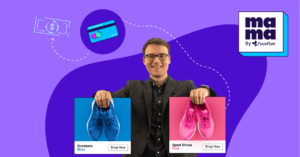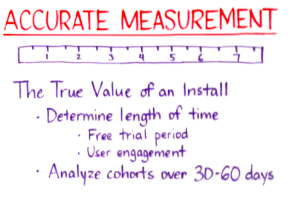
Getting started with marketing for subscription-based apps
Welcome to the twenty fifth edition of MAMA Boards, an AppsFlyer video project featuring leading mobile marketing experts on camera.
For today’s mini whiteboard master class, we have Kate Palmer, former Director of User Acquisition for Jump Ramp Games and now an independent consultant.
Among those currently used, subscription-based revenue models have become very popular in the last few years, beneficial to both developers and users alike for their high revenue and continuously engaging content. Kate walks us through the details of building her three-part UA strategy around this model, from event mapping to A/B testing to determining true install-to-subscription conversion rates, so you can get started on the right foot and dive deeper later.
Real experts, real growth. That’s our motto.
Enjoy!
Transcription
Hello and welcome to another edition of MAMA Boards by AppsFlyer. My name is Kate Palmer and I have been working in user acquisition for three years, first as the director of Lucktastic, and now as a consultant.
I have worked on and with several different types of apps, but I am here to talk to you today about subscription-based models.
Why use subscription-based app models?
In this revenue model, users pay a monthly fee to access your app, and, in return, are offered new content and incentivizing features on an ongoing basis. These apps have become super popular over the last couple of years.
On one hand, the developers love them because they typically see a higher revenue than pay-to-download, in-app purchase, and ad revenue models, but more importantly, this revenue is more reliable than other models, which allows for greater confidence in your marketing efforts and in planning major feature upgrades.
On the other hand, the users love these kinds of apps because they’re constantly being engaged with new and often exclusive content.
What in-app events should I measure for my subscription-based app?
Today, we are going to explore some practices I have found to be helpful in building a successful UA strategy for a subscription app. First and foremost, you’re going to want to start off on the right foot and set up a mobile measurement partner, such as AppsFlyer, to capture all of your relevant data. This part is going to sound a little tedious, but without a strong data foundation, you’re going to be relying on guesswork to determine your users’ behavior, make changes within the app, and to optimize your campaigns.
While every app is different, most subscription models include three main events: free trial, monthly subscriptions, and annual subscriptions.
The first event you’re going to want to measure is your free trial and this should fire when the user completes the registration form. If no registration is required, you can just use your install as your free trial event.
The second and third events that you’re going to want to measure are your monthly and your annual subscriptions; make sure that you measure them separately though. Also, be sure to include revenue parameters so that you can accurately measure your ROI on these subscriptions.
Next, I would suggest putting an event on your initiated checkout page. This is going to give you a great idea of how many people are considering your offer and then actually making a purchase. This will also be a great conversion rate that you’re going to be able to use for future optimizations.
Lastly, I think it’s really important to look at cancellations so that you can see the true life span of your users. You can do this in two ways: one, send an event to fire when a user requests cancellation and two, send your revenue monthly so it will stop when the user stops.
In an ideal world, I would do both of these, but I understand that sometimes it just isn’t possible. So if I had to choose just one, I would choose option two because you can still see the exact LTV of your users and also the length of time they were a subscriber.
Which elements of my app should I focus on optimizing?
Onboarding. Moving forward, users need to be properly onboarded to truly understand the full value of your app and why they should continue paying every month. Your onboarding flow should be well thought out to ensure as many users as possible convert to subscription. There are a lot of things that you can do to tweak your onboarding flow, but I am a huge fan of A/B testing everything. Colors, verbiage, registration forms, everything.
An interesting test that you can perform is to A/B test based on audience. A user who comes in from an interest-based campaign on Facebook may behave very differently from a user who sees an ad on a gaming network. To navigate these differences among audiences, I would A/B test your different audience types and personalize your onboarding flows.
Free trial period. A big challenge that many subscription apps face is determining the nature and the length of their free trial period. Most users will need at least some kind of temporary access to your premium content in order to be convinced to pay for it on a monthly basis.
However, every app is different. Some will offer a week or even a month of completely free content. Other apps will offer some features indefinitely, but withhold their highest content for the paying customers. There is no right or wrong answer and it really just depends on you and your user base. My suggestion to you would be to lean on your data and make sure you’re constantly analyzing all of your conversion points and optimizing against them.
Discounts. Who doesn’t love a deal? Most apps will offer discounted rates to users who commit to six or 12 months subscriptions. This is a great strategy because everybody wins. Most users will opt for the lower price plan with the extended commitment and app developers can make more reliable revenue projections. The benefit of knowing that at least a portion of your user base is going to be paying consistently for the next 6 to 12 months often far outweighs any money lost through a discounted rate.
Offering discounts also gives subscription apps a very unique retention option. If a user churns or unsubscribes and they were a monthly subscriber paying $20 a month, you can always rope them back in by sending them an offer saying, “Hey, come back and pay $15 a month.” If they don’t bite at that, you can offer them ten.
At the end of the day, it’s more important to have a user paying less than nothing at all.
Content. Because payment is monthly and recurring, expectations from your user base are going to be much higher than those of a free app or a one-off app payment. For this reason, you are going to have to frequently update your features and provide them with new content.
You have to simultaneously make your users feel comfortable enough to join you for the long haul through a seamless app experience and also excited enough to continue engaging with your app through your premium content. Interact with your users frequently, keep tabs on what kind of content they’re most interested in, then send them push notifications and emails when you launch new updates that are relevant.
How can I accurately measure the performance of my app?
So now we are accurately measuring all of our data and we’re using it to make precise and educated optimizations within our app and to our campaigns. Now, it is time to measure our performance and figure out our CPA and our ROI. Before we do this though, we first have to determine the length of time it takes to see the true value of an install.
With subscription-based apps, you can’t measure ROI and LTV the same way you would other revenue models.
Figuring out this length of time depends heavily on your free trial period, but also on how quickly you can hook those users. You may offer a 30-day free trial period, but if your users are really loving the content and they’re going inside every day and engaging with the app, you may find that those installs are turning into subscriptions within two weeks. If this is the case, I would test shortening your free trial period.
I suggest analyzing cohorts of new users over a period of 30 to 60 days to determine their behavior and the time it takes to convert to a subscription. I have only worked with seven day free trials previously and found it took an additional three weeks to see the lion’s share of these subscriptions come through.
Using that same logic, if your free trial is 30 days, give yourself a full 60 days from date of install to determine the length of time to convert. Knowing these metrics is going to help you calculate your install-to-subscription conversion rate and cost per acquisition, as well as help you become more efficient and strengthen your ROI.
Three-pronged approach to UA for subscription-based apps
To sum up, we have established a three-pronged approach to building a successful UA strategy for a subscription app. One, set yourself up for success; make sure your MMP is measuring all relevant events and capturing all of your data. Make sure that you break out your different subscription types and use the revenue parameters.
Two, optimize, optimize, optimize. There are so many different levers you can pull to drive more subscriptions more efficiently. A few good places to start would be to test different onboarding flows, play around with your free trial period, experiment with discounts, and make sure you frequently update your content.
Finally, in order to accurately measure your ROI, you’re going to have to first determine the length of time it takes to see the true value of an install.
I hope you all enjoyed today’s video.
If you have any questions or comments, please leave them below. Be sure to check out more MAMA Boards here at this link.
Thank you so much! Have a great day!








